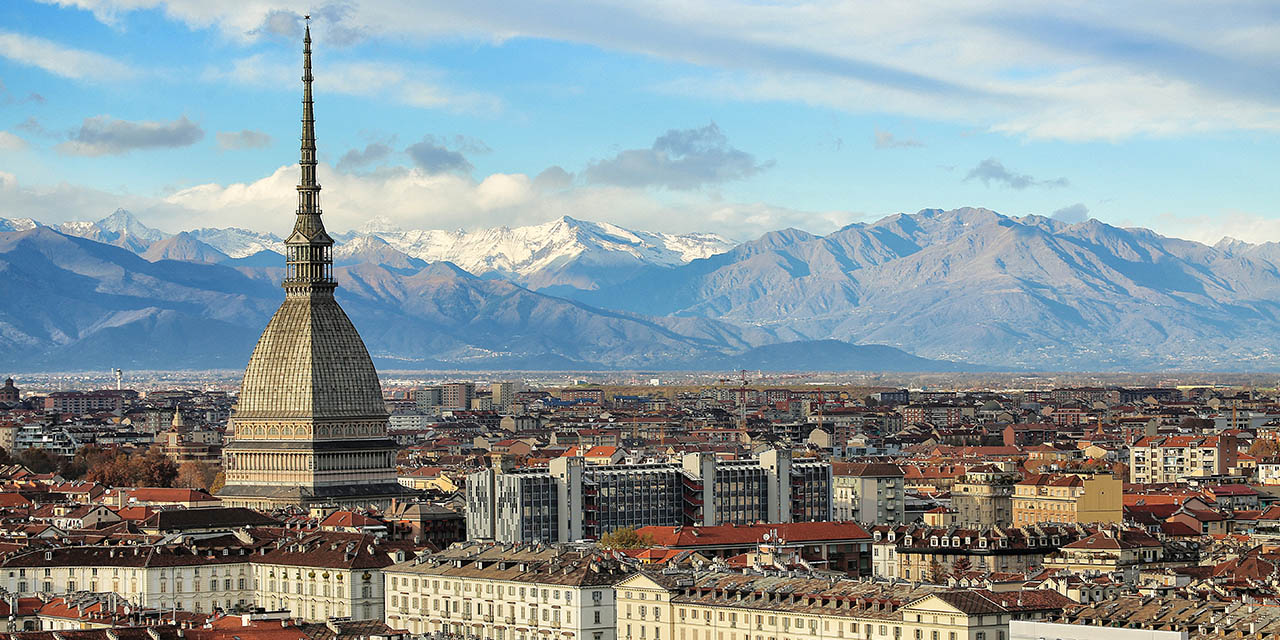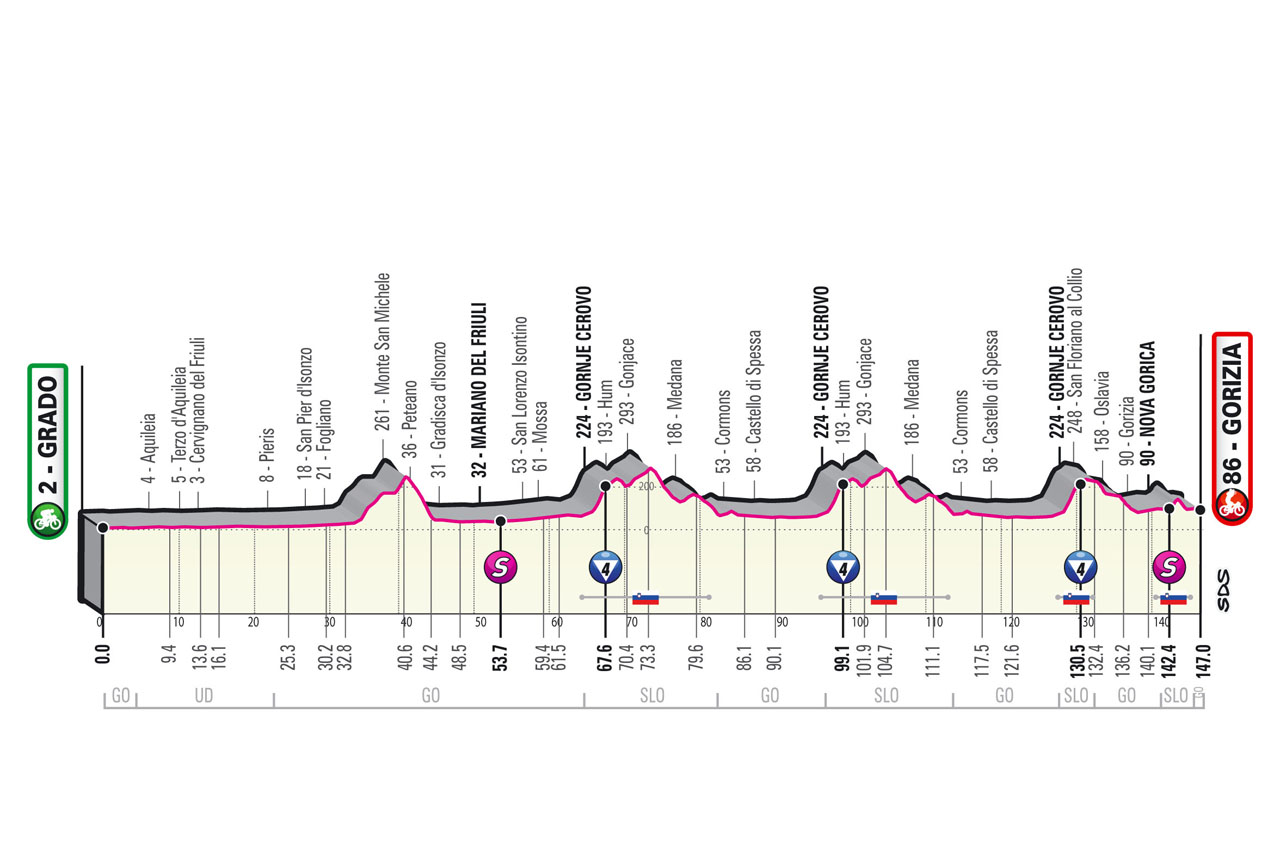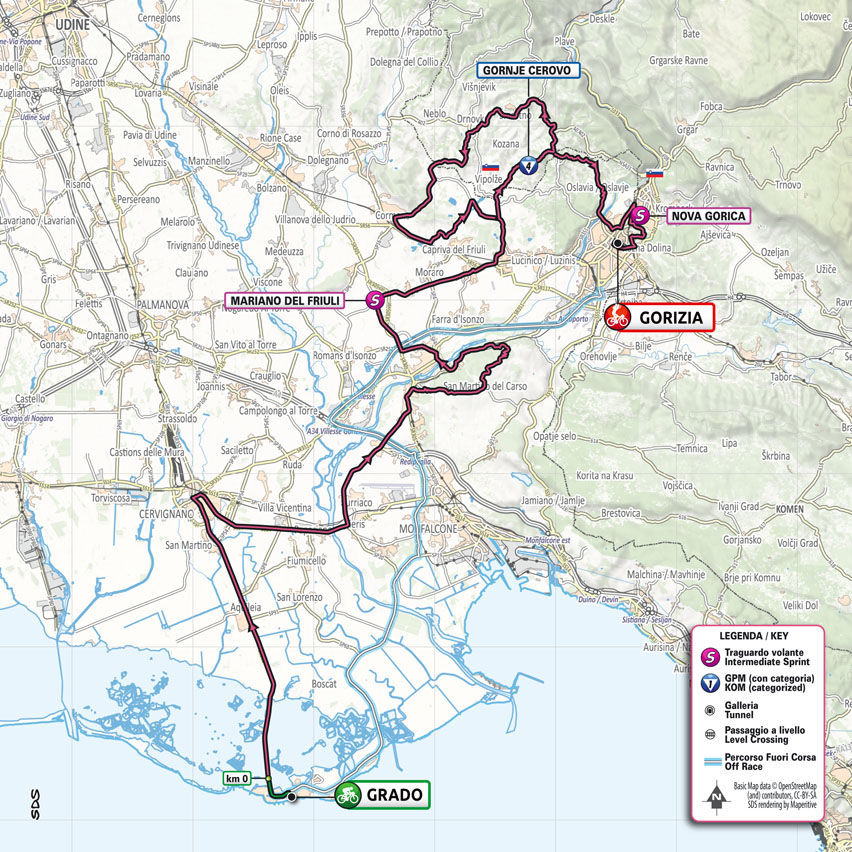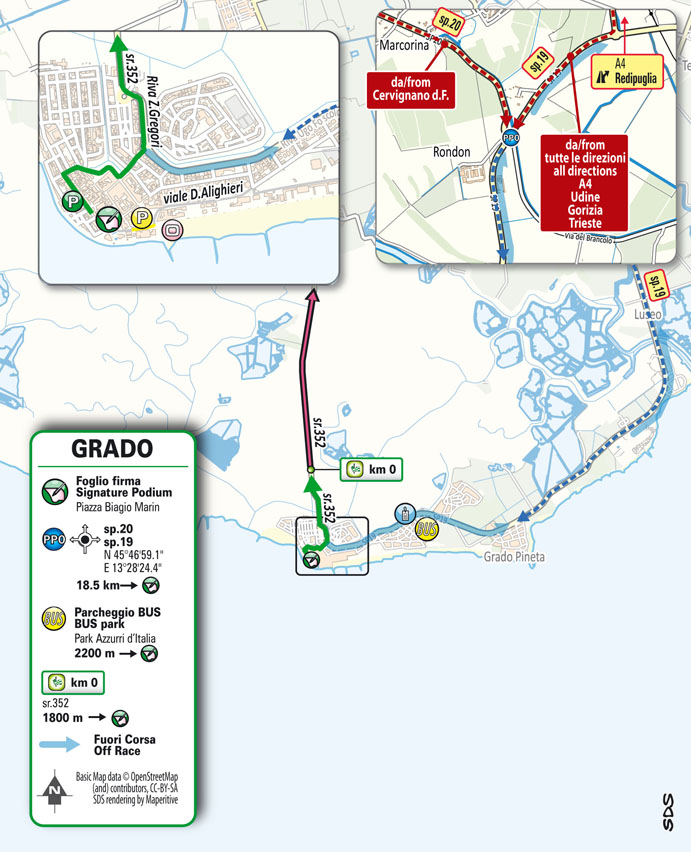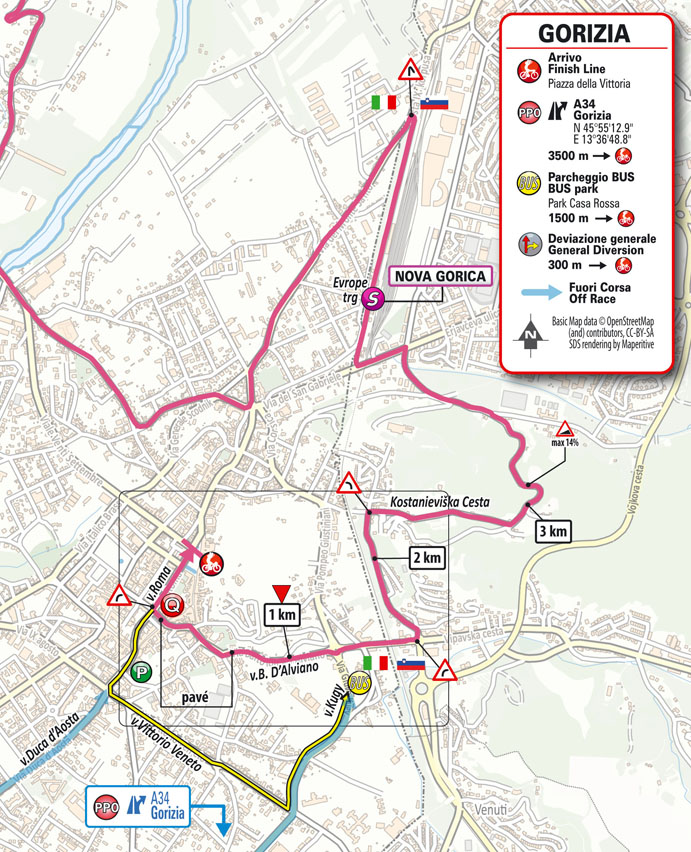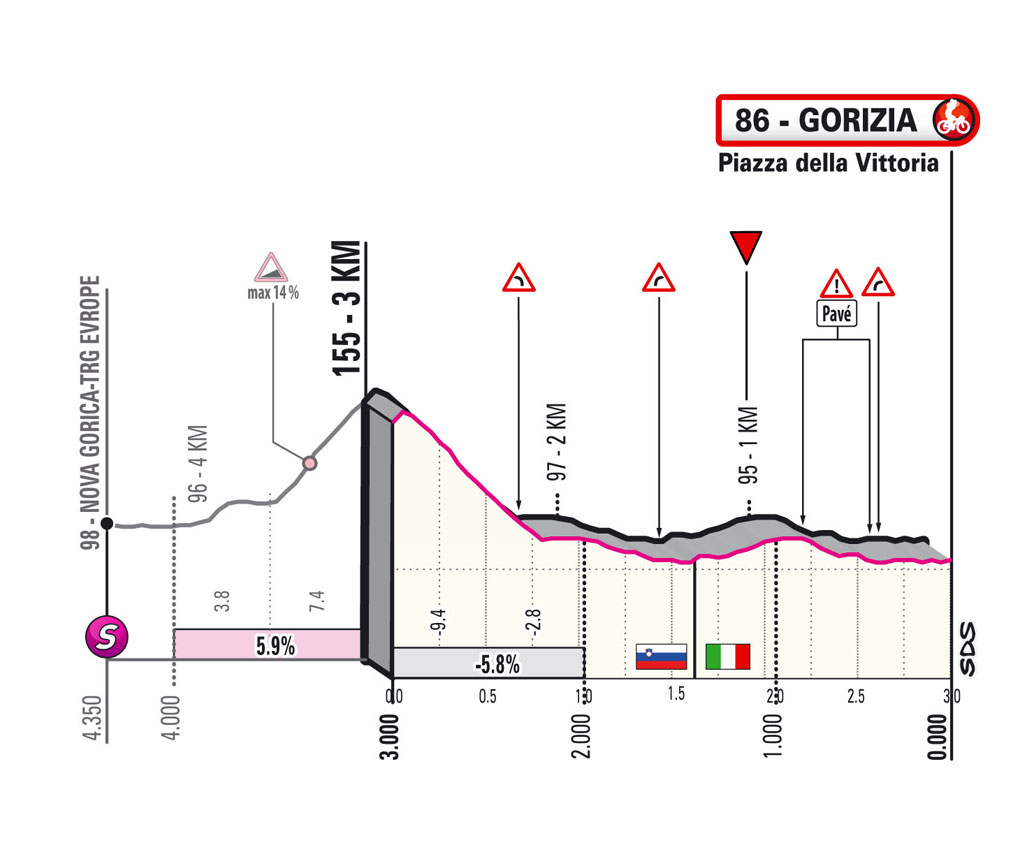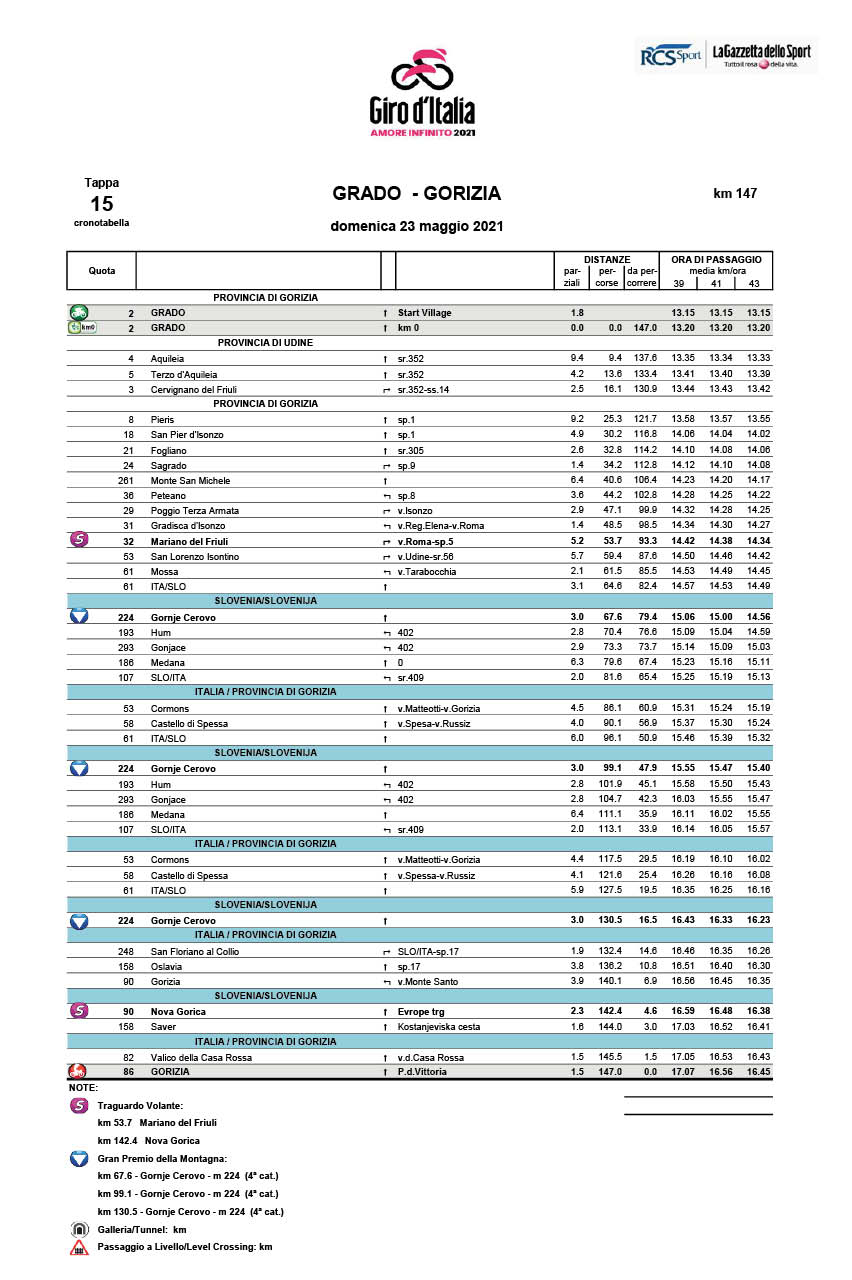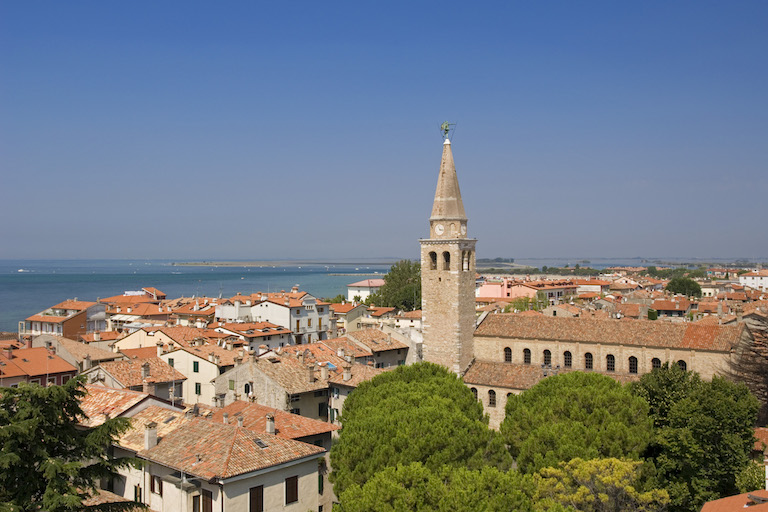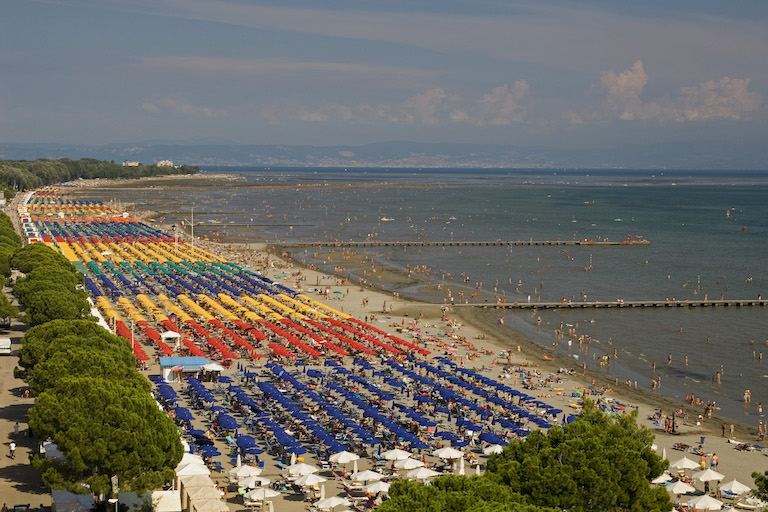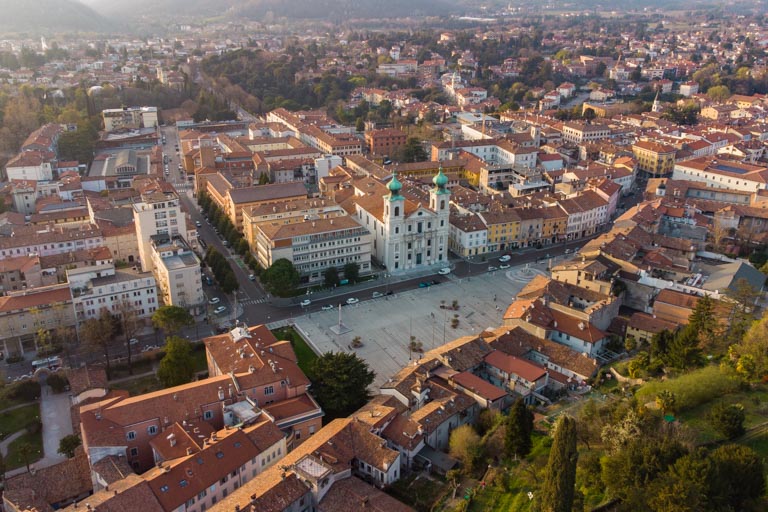profile
map
technical info
A short stage with a cross-border circuit between Italy and Slovenia of approx. 40 km. The route begins flat, all the way to Sagrado, and then clears the Monte San Michele climb. Starting in Mossa, the circuit features three passes over the steep, 2 km long Gornje Cerovo climb (each awarding KOM points), and a succession of tough climbs and descents. After the third lap, the route goes back to Italy through San Floriano del Collio, passes north of Gorizia and crosses the border again, passing through Nova Gorica.
Final kilometres
The last 5 km are raced partly in Slovenia and partly in Italy. Past Piazza Europa (trg Evrope), the route ascends for nearly 1 km at 14% max. gradients, and then takes a technical descent leading back to Italy. Over the final kilometre, the route covers a short stretch on stone pavers. The home straight is 300 m long, on tarmac road.
start / finish
climb detail
final kilometres
itinerary timetable
tourist info
Host city:
Grado
Overview
Suspended between sky, earth and sea, also known as the “Island of the Sun” due to its south-facing sandy beaches, Grado in Friuli Venezia Giulia is one of Italy’s most historically rich seaside towns and lies in the middle of the northernmost of the Adriatic Sea’s lagoons. The town is internationally known as a thermal bath centre as well as a prestigious seaside destination, which developed in the late 19th century during the Habsburg Empire. As evidence of the city’s ancient and important history, also known as the first Venice, three well-preserved jewels can still be admired today: the Basilica of Santa Eufemia, the elegant Baptistery and the Basilica of Santa Maria delle Grazie. The historic centre is a picturesque labyrinth of calli and campielli, with traditional architecture marked by stone and brick walls, narrow external stairways (balaors) and characteristic chimneys (fugher). The urban grid has remained almost homogeneous and unchanged over time, the typical appearance of an Upper Adriatic seaside village.
Speciality food
The most famous gradese dish, celebrated by the gradese poet Biagio Marin, is ‘Boreto a la graisana’, an ancient and unique fish soup, accompanied by white corn polenta and characterised by the simplicity of its ingredients (fresh fish, extra virgin olive oil, garlic, salt, black pepper and vinegar); this soup has dozens of variants, all of them tasty. Created by the fishermen of the lagoon (casoneri) and handed down for generations, it was originally made with fresh fish that could not be sold at the market. The recipe never includes tomatoes, which suggests that it was part of the Grado fishermen’s food tradition even before the discovery of America. Because of its extraordinary history, “Boreto a la graisana” has been included in the list of traditional food products of Friuli Venezia Giulia since spring 2019. Another typical product of Grado’s culinary tradition is the white asparagus of Fossalon; the sandy soils of Fossalon, an agricultural suburb of Grado, are an ideal growing place for the white shoots, which are harvested from the end of April to the beginning of June. In May takes place the “Fossalon Asparagus Exhibition”, during which the “sgorbia d’argento” (the traditional tool used to harvest white asparagus) is awarded to the best producer of white asparagus in Friuli Venezia Giulia.
Drinks
Vines are not cultivated on the islands of the lagoon of Grado. The environment is not favourable but, above all, there is no need. The nearby mainland, with the Aquileia DOC, offers quality bottles with a wide choice of excellent white and red wines, from the hills and the plains. A characteristic drink of Grado is Santonego, a special alcoholic infusion of marine absinthe (Artemisia coerulescens), a perennial aromatic lagoon plant with bitter-tonic properties and silver-green leaves, which flowers between August and September. An intoxicating grappa-based elixir containing in its dry aftertaste with a bitter ending, all the wisdom and traditions of Grado’s families; it can also be enjoyed with oysters and chocolate.
Main sights
Remarkable sights in the historic centre are the Basilica of Santa Eufemia, the elegant Baptistery and the Basilica of Santa Maria delle Grazie.
Gorizia
Overview
Nestled between plains and mountains, in the extreme northeast of Italy, strtching on the banks of the Isonzo, where Latin, Slavic and Germanic cultures meet, Gorizia is today, an authentic symbol of the Europe that will be. This is Gorizia, a treasure chest that holds charms and mysteries and which, together with the bordering, Slovenian city of Nova Gorica, was recently named European Capital of Culture for 2025. This nomination sends out an important message, imagining a Europe truly without borders and in which the protagonists are the citizens. But if the future represents a fascinating challenge, Gorizia also has a lot of history and an important past to tell. Also known as the “Nice of Austria”, for its mild climate and the elegance of the views that unfold from its centre at the foot of the medieval castle hill, Gorizia was at the heart of the tragic events of the First and Second World Wars, but today finds its identity as a city of culture, gastronomy, and multiculturalism.
Speciality food
The gastronomy of Gorizia, set in a truly Central European tradition, draws heavily from the different souls of the city and its territory, from the different cultures and influences that can be found everywhere in its streets and squares. And, thus, in its dishes and on its tables. The cusine of Gorizia is characterized by hearty dishes but, at the same time, it is refined and rich in peculiarities, which are able to fascinate even the most demanding palates. Among the first courses one cannot fail to mention its soups and broths, starting with the jota, a special soup of beans and potatoes enriched, depending on the variants and recipes, with sauerkraut or “brovada”. The legacy of the city’s long belonging to the Austro-Hungarian Empire is the goulasch: a rich spiced meat soup, to be accompanied with bread gnocchi or polenta. Among the most original dishes of the area, one finds certainly Gorizia’s gnocchi, stuffed with plums, and which, despite their markedly sweet taste, are considered to all intents and purposes a first course. Also, famous and enticing is the “ljubljanska” that can be tasted in the many restaurants in the city centre. The steak, stuffed with ham and cheese, is served fried and steaming. Finally, to stay within the main courses, in spring, an omelette with wild herbs is not to be missed. The “gubana” from Gorizia, with its delicate puff pastry and dried fruit filling, or the traditional “strucolo in straza”, in its many variations, jealously guarded by every family, are the best way to end a meal on a sweet note. On the other hand, among the gastronomic products of absolute excellence, in addition to honey, the delicious radicchio “Rosa di Gorizia” stands out, so beautiful in its forms, it has nothing to envy to a flower, and with a unique and only slightly bitter flavour, unlike that of any other radicchio.
Drinks
Located right at the foot of the Collio hills, bathed by the emerald waters of the Isonzo that fecundates the hills and the surrounding plain, and with a view that also sweeps towards the nearby Karst, Gorizia is also a land of luxuriant orchards and vineyards, in which some of the best wines in the world are produced. Above all stands the Ribolla Gialla which on the heights of Oslavia has found its elected ground, and which represents the flag wine of Gorizia. The soil, rich in minerals, the particular exposure, the ventilation and the ideal temperature range, they all give life to an extraordinary wine that the local producers have been able to reinterpret also by retrieving an ancient technique of maceration on the grape’s skins. But with the Ribolla, the vineyards around Gorizia also produce the magnificent Friulano – which enthusiasts cannot but continue to call Tocai -, in addition to the various Sauvignons, Pinot Grigio, Merlot and Cabernet. All excellences that can be found in the many bistros and wine bars in the city centre… although it would be sufficient to walk for just a few minutes down the city roads to end up into the vineyards on the outskirts of the city, and there enter the cellars and get to know directly the wine producers. Gorizia and the Isontino are a land of great wines, especially white ones, but obviously there is also room for liqueurs, such as the famous Pelinkovac, a bitter, absinthe based, typical liquor of the entire Balkan area, that boasts a long tradition even on the shore of the Isonzo. Wine lovers and connoisseurs, however, for several years now, in Gorizia, can also dive in the world of beer, tasting the productions of the craft brewery born in its territory.
Main sights
It is not difficult to imagine why the great painter Max Klinger described Gorizia as the most beautiful door open to Italy; and, why, in the past centuries, figures such as Giacomo Casanova and Carlo Goldoni were fascinated by the city there; and why today actors and directors such as Carlo Verdone see Gorizia as jewel of a city. Every visitor, famous or not, noticed and still perceives a particular atmosphere, one stemming from the many different souls and traditions that make Gorizia so unique. History is reflected in the clear waters of the Isonzo, considered one of the most beautiful rivers in Europe; from the Middle Ages (the city is mentioned for the first time in an official document in 1001) to the twentieth century (just think of the tragic events of the First and the Second World Wars), history has left precious monuments and testimonies as a dowry. From the top of its hill, the medieval castle, symbol of the Princely county, watches over Gorizia. It is said that, on certain nights, it is still possible to see the tormented silhouette of the ghost of the White Lady reflected on the Castle walls. From the next year, it will be possible to reach the castle also by the modern lift that will rise from Piazza Vittoria, situated right at the foot of the hill. Meanwhile, modern multimedia technologies make its visit a memorable experience. Among the jewels of the city there are certainly the Viatori Gardens, with blooms that are an authentic treasure for enthusiasts and photographers, and the Coronini Cronberg Palace, where the last Bourbon king of France, Charles X, spent his last days; and today his remains rests a few hundred meters from the border, in the Castagnevizza Monastery, where he was buried together with his family, including Mariateresa Carlotta, the daughter of Marie Antoinette and Louis XVI. Palazzo Coronini, among other things, showcases the only two “Heads of character” of the great German sculptor Messerschmidt, now present in Italy. The oldest synagogue in the whole Friuli Venezia Giulia Region is set in the former Jewish ghetto of Gorizia. If on the heights of Oslavia, at the gates of the city, the Ossuary stands out in its candid white stone, housing the remains of over 57,000 soldiers who died in the Great War, Piazza Transalpina is an extraordinary symbol of of the Second World War. It was then that it became a place divided by the border, whilst today it is a shared place, an image of the new Europe, where visitors can keep one foot in Italy and one in Slovenia at the same time. It will be here that the 15th stage of the Giro d’Italia, in its last kilometres will pass, before reaching the finish line in Piazza Vittoria, in front of the Fountain of Neptune designed by Nicolò Pacassi, and at the foot of the great church of Sant’Ignazio with its characteristic onion bell tower. Piazza Vittoria, like the whole historic centre, is also the location for “Gusti di frontiera”, the largest food and wine festival in the northeast of Italy. The festival brings tastes from all over the world to Gorizia, attracting almost a million visitors every yar. Other important events are “Contea”, and the “èStoria” cultural festival, the “Amidei” film award and the World Folklore Festival.











